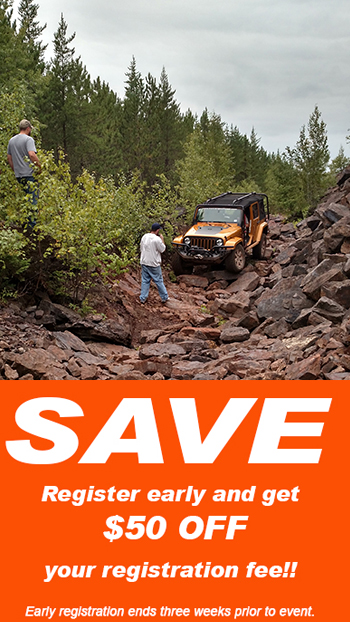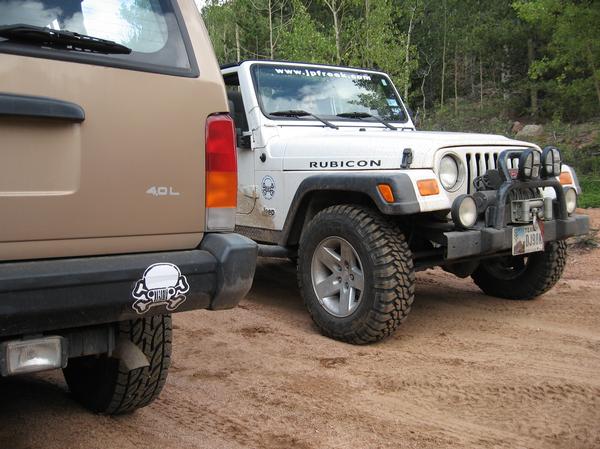Pressure situations happen to all of us in many aspects of our lives.
Most of the time, too much pressure can lead to serious problems…at work, at home, at school…even in your tires! Let’s take a few minutes in this issue’s column to talk about correct tire pressure. Some folks barely give it a second thought but for anyone exploring the backcountry or doing some heavy hauling, tire pressure is a critical part of safe and successful travel.
One of the first things we do at Iron Range Offroad classes (right after talking about the ground rules of safety and environmental responsibility) is air down the tires. We do this to allow the tire to work more effectively over the trail. The wider footprint distributes the weight of the rig over a greater surface area (minimizing trail impact). The flex of the sidewall allows the tire to “conform” to the obstacles and grab onto rocks or stumps, and the flex of the tread allows it to dig into mud or dirt. Airing down can make an amazing difference in how much traction the tire is able to provide, and how easily you are able to manage the terrain.
How much you air down depends on a number of factors. Different types of tires (radial vs. bias ply, all terrain vs. mud terrain, stock size vs. oversize), different type of wheels (steel vs. aluminum, beadlocked vs. non-beadlocked), and even expected terrain might affect your decision how much to air down.
On one of my first 4 wheeling adventures (in the Black Hills of South Dakota many years ago) I was third in line of a pretty big group of Jeeps. As we started to climb a pretty steep hill of loose “scrabble”, I found myself spinning and sliding sideways. Before I could get into serious trouble, I backed down and lined up for another attempt. The group gathered to watch. I made it about as far on the second attempt and spun my tires into the hill. At this point one of the ol’ timers (chewing on a blade of grass) asked if I aired down. “Sure did,” I replied. I had dropped from 35 psi all the way down to 27psi. My third attempt was equally futile, and the ol’ timer repeated that he thought I had too much air. I got out of the way to let the other Jeeps pass while I aired down some more…at his recommendation down below 15psi. My tires looked almost flat, with the sidewalls bulging out and certainly didn’t feel like anything I was used to driving on.
What a difference it made! He made a believer out of me as my Jeep crawled up that hill without spinning a tire. It made for a more comfortable ride (squishing the sidewalls absorbs some of the bumps kind of like an extra shock absorber), and gave me a lot more confidence as the trail got tougher and rockier. I ran the rest of that day with no traction issues and promptly figured out how to address a new problem: how do you air down that far without kneeling next to each tire with a key stuck into the valve stem?
There are many solutions. You can buy 4 deflators that screw onto the valve stems. They are adjustable to a pre-set pressure and stop when the tire reaches that pressure. Another option is a gauge with a valve tool built in. You screw the gauge onto the valve stem then unscrew the valve itself. The tool captures the tiny, needle-like valve and holds it while air rushes past much faster than simply depressing the valve with your key. You’re still kneeling, but for seconds rather than minutes, and the valve cannot fly off and disappear on a high pressure airflow stream. The tool gets passed around between several Jeeps in the time it takes to manually air down one.
My favorite low buck solution is a clip-on air chuck (about $10). The clip holds it in place so you can stand up, and since it’s unconnected from the air hose, it simply bleeds off the air pressure in the tire. After checking the decreasing pressure a few times, I have learned it takes about 45 seconds to get close to my target pressure number. I keep this tool in the glove box where it stays clean and handy, as I know I’ll be using it again when I air up later.
Speaking of airing up, it is absolutely critical that you re-inflate the tires back to normal pressure before driving at highway speeds! The reason is safety. The lower pressure does not force the rubber bead of the tire into the rim as much, and the bead can peel as road forces (like cornering) push the weight of the vehicle against the outer edge of the rim. Peeling a bead causes “catastrophic loss of pressure”, and will likely cause a crash. We are less concerned about peeling a bead at trail speeds since we are traveling so slowly, but peeling a bead is still inconvenient and there are solutions to help prevent this.
Most commonly you see a Jeep with beadlocked wheels. These are rings that are used with a specially modified rim to pinch the bead of the tire directly to the wheel. Bolts are used to hold the ring and tire in place. Some drawbacks include: You are only pinching the outer bead (the inner bead is still capable of peeling), the rings tend to hold mud (or small rocks) that will require some extra work to clean out, and most beadlocks are not DOT approved (meaning you cannot legally run them on the road).
One DOT approved solution is “internal dual beadlocks”. It is a heavy duty inner tube that has its own valve stem (you are required to drill a hole in the rim during installation). Once the tire is seated, the inner bladder is inflated, forcing BOTH the inner bead and outer bead against the rim. Air pressure can be controlled in the tire without affecting the bead, because the inner tube is holding the bead in place. You still need to air up for highway speeds because the tire and tread have to carry the load, but the issue of peeling a bead is significantly diminished.
Speaking of load carrying, another tire pressure question that often comes up in class:
If the tire says 50 psi on the sidewall, can you run them at 35 psi on the road or is that not good for the tire?
The sidewall pressure number is the psi required to run the maximum weight rating of the tire. Most Jeep vehicles do not weigh anywhere close to that max (even when loaded with all your gear). The best way to KNOW how much weight you run is to take your loaded rig (plus fuel and passengers) and visit one of those truck stop scales. Take your weight and divide it by 4 (assuming all 4 tires are on the ground) and make sure you are under the weight carrying capacity of the tire. I know a lot of people tow their Jeeps to the trailhead and some seriously overload their tow rig’s tire capacity. Running these trucks at anything less than maximum pressure decreases the safety factor even more.
Once you know the tires can handle the weight you are carrying, you can determine just how much pressure you need. Too much pressure and you will prematurely wear the center of the tread. Too little pressure and you will wear the edges and possibly destroy the tire (and maybe your Jeep and yourself).
A common technique to make sure your pressure is correct is to make a chalk line across the tread of all 4 tires. Drive a few blocks on dry pavement and inspect where the chalk wore off. Experiment a little with different pressures until the chalk is wearing evenly. That determines how much air pressure is needed to support the weight of the vehicle for on road use.
Many people find subtle advantages to fine tuning tire pressure like this. “Bouncy” ride might go away because too much pressure was not allowing the tire to absorb road impact properly (think about how an over inflated basketball is harder to dribble). Handling will improve if your pressure was too low (sidewall “squirm” makes high speed cornering a challenge). A few minutes of quality time with a good tire pressure gauge can help ensure your tire investment will last a long time, provide trouble free service, and give you the best possible traction both on and off the road.












